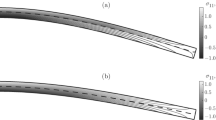In a geometrically linear formulation based on the use of variation principles of elasticity theory, the twodimensional equations of statics and the boundary conditions at the edge of an orthotropic bending plate are obtained within the framework of the classical theory and two low-order nonclassical theories: Reddy–Nemirovskii and Margueere–Timoshenko–Naghdi ones. It is shown that using the hypotheses of the classical theory, the two-dimensional static equations and the corresponding boundary conditions ensure the equilibrium of an arbitrary subarea of the structure and of the entire plate as a rigid whole; within the framework of the Reddy–Nemirovskii theory, this equilibrium is disturbed in moments and forces in the transverse direction; within the framework of the Margueere–Timoshenko–Naghdi theory, the equilibrium is disturbed in the membrane forces and moments. An example of cylindrical bending of rectangular elongate orthotropic and isotropic plates clamped along one longitudinal edge and loaded in the transverse direction on the other longitudinal edge is considered. It is shown that, within the framework of the classical, Reissner, and Ambartsumyan theories, this problem is statically determinate and the shearing force, according to these theories, is determined elementary by the method of sections. According to the Reddy–Nemirovskii theory, this problem is statically indeterminate and has a rather awkward solution. It is demonstrated that, within the framework of the Reddy–Nemirovskii theory, the shearing force is zero on the clamped edge, i.e., the plate as a whole cannot be in equilibrium. In the vicinity of such an edge, there arises a pronounced false boundary effect, which does not take place in reality, because it is located inside the zone of the boundary layer and cannot be calculated by this theory.




Similar content being viewed by others
Notes
For convenience of presentation, the through numbering initiated in [1] is continued here
References
A. P. Yankovskii, “Critical analysis of the equations of statics in the bending theories of composite plates obtained on the basis of variational principles of elasticity theory. 1. General theories of high orders,” Mech. Compos. Mater. 56, No. 3, 271-290 (2020).
J. N. Reddy, “A simple higher-order theory for laminated composite plates,” J. Appl. Mech. 51, No. 4, 745-752 (1984).
Yu. V. Nemirovskii and B. S. Reznikov, Strength of Structural Elements of Composite Materials [in Russian], Novosibirsk, Nauka (1986).
K. Belkaid, A. Tati, and R. Boumaraf, “A simple finite element with five degrees of freedom based on Reddy’s thirdorder shear deformation theory,” Mech. Compos. Mater., 52, No. 2, 257-270 (2016).
S. K. Golushko, and Yu. V. Nemirovskii, Direct and Inverse Problems of the Mechanics of Elastic Composite Plates and Shells of Revolution [in Russian], M., Fizmatlit (2008).
A. N. Andreev and Yu. V. Nemirovskii, Multilayer Anisotropic Shells and Plates. Bending, Stability, and Vibrations [in Russian], Novosibirsk, Nauka (2001).
S. G. Lekhnitskii, Anisotropic Plates [in Russian], М., L., OGIZ (1947).
L. H. Donnell, Beams, Plates and Shells, N.Y., McGraw-Hill (1976).
V. L. Biderman, Mechanics of Thinwalled Structures. Statics [in Russian], M., Mashinostroenie (1977).
V. V. Vasiliev and E. Morozov, Advanced Mechanics of Composite Materials and Structural Elements, Amsterdam, Elsevier (2013).
S. A. Ambartsumyan, Theory of Anisotropic Plates. Strength, Stability and Vibrations [in Russian], M., Nauka (1987).
K. Washizu, Variational Methods in Elasticity and Plasticity, Oxford; N.Y.; Toronto; Sydney; Paris; Frankfurt: Pergamon Press (1982).
E. I. Mikhailovskii, Mathematical Models of the Mechanics of Elastic Bodies [in Russian], Syktyvkar, Izd. Syktyvkar. Univ (2007).
P. O. Galfayan, “Solution of a mixed problem of elasticity theory for a rectangular,” Izv. Akad. Nauk. Armyansk SSR, Fiz. Mat. Nauki, XVII, No. 1, 39-61 (1964).
L. Aghalovyan, Asymptotic Theory of Anisotropic Plates and Shells, London; Singapore, World Sci. Publ. (2015).
A. P. Yankovskii, “Deflections of uniformly stressed reinforced plates with account for their weakened resistance to the transverse shear,” J. Appl. Mech. Techn. Phys., 58, No. 1, 173-181 (2017)
A. A. Smerdov, I. A. Buyanov, and I. V. Chudnov, “Analysis of optimum combinations of requirements to carbon-fiber plastics developed for large-size space-rocket structures,” Izv. Vuzov, Mashinostroenie, No. 8, 70-77 (2012).
S. A. Ambartsumyan, General Theory of Anisotropic Shells [in Russian], M., Nauka (1974).
A. Andreev, Elasticity and Thermoelasticity of Layered Composite Shells. Mathematical Model and Some Aspects of Numerical Analysis, Saarbrucken (Deutschland), Palmarium Academic Publ. (2013).
J. N. Reddy, “A refined nonlinear theory of plates with transverse shear strain,” Int. J. of Solids and Structures, 20, No. 9, 881-896 (1984).
N. A. Abrosimov and V. G. Bazhenov, Nonlinear Problems of the Dynamics of Composite Structures [in Russian], N. Novgorod, Izd. NNGU (2002).
Author information
Authors and Affiliations
Corresponding author
Additional information
Note 1. see [1]
Translated from Mekhanika Kompozitnykh Materialov, Vol. 56, No. 4, pp. 649-674, July-August, 2020.
Rights and permissions
About this article
Cite this article
Yankovskii, A.P. Critical Analysis of the Equations of Statics in the Bending Theories of Composite Plates Obtained on the Basis of Variational Principles of Elasticity Theory 2. Particular Low-Order Theories. Mech Compos Mater 56, 437–454 (2020). https://doi.org/10.1007/s11029-020-09895-1
Received:
Revised:
Published:
Issue Date:
DOI: https://doi.org/10.1007/s11029-020-09895-1




